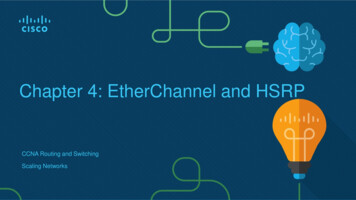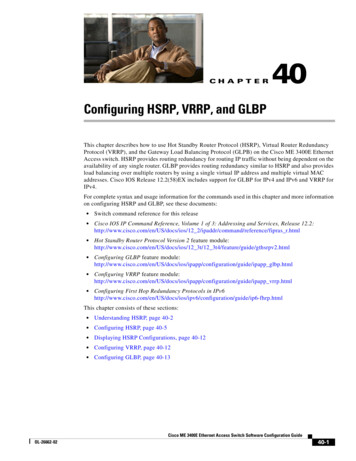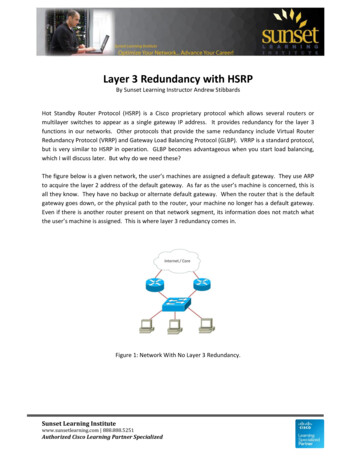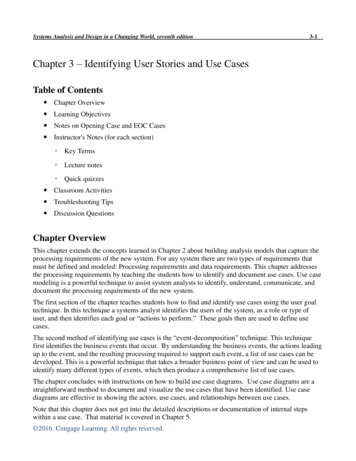
Transcription
Chapter 4: EtherChannel and HSRPCCNA Routing and SwitchingScaling Networks
Chapter 4 - Sections & Objectives 4.1 Link Aggregation Concepts Explain link aggregation operation in a switched LAN environment. Describe link aggregation. Describe EtherChannel technology. 4.2 Link Aggregation Configuration Implement link aggregation to improve performance on high-traffic switch links. Configure link aggregation. Troubleshoot a link aggregation implementation. 4.3 First Hop Redundancy Protocols Implement HSRP Explain the purpose and operation of first hop redundancy protocols. Explain how HSRP operates. Configure HSRP using Cisco IOS commands. Troubleshoot HSRP. 2016 Cisco and/or its affiliates. All rights reserved. Cisco Confidential2
4.1 Link Aggregation Concepts 2016 Cisco and/or its affiliates. All rights reserved. Cisco Confidential3
Link AggregationIntroduction to Link Aggregation It is possible to combine the number of physical links between switches to increase the overallspeed of switch-to-switch communication. STP will block redundant links to prevent routing loops.Redundant Links with STP (by default blocked) 2016 Cisco and/or its affiliates. All rights reserved. Cisco Confidential4
Link AggregationAdvantages of EtherChannel Most configuration tasks can be done onthe EtherChannel interface instead of oneach individual port. EtherChannel relies on existing switchports. Load balancing takes place between linksthat are part of the same EtherChannel. EtherChannel creates an aggregation thatis seen as one logical link. EtherChannel provides redundancybecause the overall link is seen as onelogical connection. 2016 Cisco and/or its affiliates. All rights reserved. Cisco Confidential5
EtherChannel OperationImplementation Restrictions EtherChannel groups multiple physical ports into one or more logical EtherChannel links. EtherChannel Restrictions Interface types cannot be mixed. (FastEthernet Gigabit Ethernet cannot be grouped.) Provides full-duplex bandwidth up to 800 Mbps(Fast EtherChannel) or 8 Gbps (GigabitEtherChannel) Cisco IOS Switch can support 6 EtherChannels. Created between two switches or a server andswitch. If one side is configured as trunk, the other sidemust be a trunk within same native VLAN. Each EtherChannel has a logical port channelinterface and changes to a channel affects itsphysical interfaces. 2016 Cisco and/or its affiliates. All rights reserved. Cisco Confidential6
EtherChannel OperationPort Aggregation Protocol EtherChannels can be formed by using PAgP or LACP protocol PAgP (“Pag-P”) Cisco-proprietary protocol 2016 Cisco and/or its affiliates. All rights reserved. Cisco Confidential7
EtherChannel OperationLink Aggregation Control Protocol LACP multivendor environment 2016 Cisco and/or its affiliates. All rights reserved. Cisco Confidential8
4.2 Link Aggregation Configuration 2016 Cisco and/or its affiliates. All rights reserved. Cisco Confidential9
Configuring EtherChannelConfiguration Guidelines Configuration Settings Match on Both Switches Same speed and duplex mode. All interfaces in a bundle must be assigned to the same VLAN, or configured as a trunk. Trunk must support same range of VLANs. 2016 Cisco and/or its affiliates. All rights reserved. Cisco Confidential10
Configuring EtherChannelConfiguration Guidelines (Cont.) If Configuration Settings Do Not Match EtherChannel not formed between S1 and S2Note: When changing settings, configure them in portchannel interface configuration mode. The configurationapplied to the port channel interface also affects theindividual interfaces. 2016 Cisco and/or its affiliates. All rights reserved. Cisco Confidential11
Configuring EtherChannelConfiguring Interfaces This configuration creates EtherChannel with LACP and configures trunking. Step 1: Specify the interfaces that compose the EtherChannel group. Step 2: Create the port channel interface with the channel-group command in active mode. (Channelgroup number needs to be selected.) Step 3: Change Layer 2 settings in port channel interface configuration mode. 2016 Cisco and/or its affiliates. All rights reserved. Cisco Confidential12
Verifying and Troubleshooting EtherChannelVerifying EtherChannelVerifies the interface status.Displays a one-line summaryper channel group.SU indicates in use. 2016 Cisco and/or its affiliates. All rights reserved. Cisco Confidential13
Verifying and Troubleshooting EtherChannelVerifying EtherChannel (Cont.)Displays port channelinformation. 2016 Cisco and/or its affiliates. All rights reserved. Cisco Confidential14
Verifying and Troubleshooting EtherChannelVerifying EtherChannel (Cont.)Displays role of particularinterface in an EtherChannel. 2016 Cisco and/or its affiliates. All rights reserved. Cisco Confidential15
Verifying and Troubleshooting EtherChannelTroubleshooting EtherChannel All interfaces within EtherChannel must have the same: speed duplex mode native and allowed VLANs on trunk (Ports with different native VLANs cannot form anEtherChannel.) assigned to same VLAN 2016 Cisco and/or its affiliates. All rights reserved. Cisco Confidential16
Verifying and Troubleshooting EtherChannelTroubleshooting EtherChannel (Cont.)Output indicates that theEtherChannel is down (SD). 2016 Cisco and/or its affiliates. All rights reserved. Cisco Confidential17
Verifying and Troubleshooting EtherChannelTroubleshooting EtherChannel (Cont.)Incompatible PAgP modesconfigured on S1 and S2. 2016 Cisco and/or its affiliates. All rights reserved. Cisco Confidential18
Verifying and Troubleshooting EtherChannelTroubleshooting EtherChannel (Cont.)PAgP mode on the EtherChannelis changed to desirable and theEtherChannel becomes active. 2016 Cisco and/or its affiliates. All rights reserved. Cisco Confidential19
4.3 First Hop Redundancy Protocols 2016 Cisco and/or its affiliates. All rights reserved. Cisco Confidential20
Concept of First Hop Redundancy ProtocolsDefault Gateway Limitations A mechanism is needed to provide alternatedefault gateways in switched networks wheretwo or more routers are connected to thesame VLANs. Note: In the graphic, a multilayer switch isacting as the default gateway and used forrouting. In a switched network, each client receivesonly one default gateway. There is no way to use a secondary gateway,even if a second path exists to carry packetsoff the local segment. In the figure, R1 is responsible for routingpackets from PC1. If R1 becomesunavailable, R2 can route packets that wouldhave gone through R1. End devices are typically configured with asingle IP address for a default gateway. If that default gateway IP address cannot bereached, the local device is unable to sendpackets off the local network. 2016 Cisco and/or its affiliates. All rights reserved. Cisco Confidential21
Concept of First Hop Redundancy ProtocolsRouter Redundancy To prevent a single point of failure at the defaultgateway, implement a virtual router. Present the illusion of a single router to the hostson the LAN. By sharing an IP address and a MAC address,two or more routers can act as a single virtualrouter. IPv4 address of the virtual router is configured asthe default gateway for the workstations on aspecific IPv4 segment. ARP resolution returns the MAC address of thevirtual router. Physical router that forwards traffic is transparentto the host devices. A redundancy protocol provides themechanism for determining which routershould take the active role in forwardingtraffic. Ability of a network to dynamically recoverfrom the failure of a device acting as a defaultgateway is known as first-hop redundancy. 2016 Cisco and/or its affiliates. All rights reserved. Cisco Confidential22
Concept of First Hop Redundancy ProtocolsSteps for Router Failover When the active router fails, the redundancyprotocol transitions the standby router to thenew active router role. These are the steps that take place when theactive router fails:1. The standby router stops seeing hellomessages from the forwarding router.2. The standby router assumes the role of theforwarding router.3. Because the new forwarding router assumesboth the IPv4 and MAC addresses of thevirtual router, the host devices see nodisruption in service. 2016 Cisco and/or its affiliates. All rights reserved. Cisco Confidential23
Concept of First Hop Redundancy ProtocolsFirst Hop Redundancy Protocols Hot Standby Router Protocol (HSRP) - A Cisco-proprietary FHRP designed to allow for transparentfailover of a first-hop IPv4 device. Active device is the device that is used for routingpackets. Standby device is the device that takes over whenthe active device fails. Function of the HSRP standby router is to monitorthe operational status of the HSRP group and toquickly assume packet-forwarding responsibility if theactive router fails. HSRP for IPv6 - Cisco-proprietary FHRP providingthe same functionality of HSRP, but in an IPv6environment. 2016 Cisco and/or its affiliates. All rights reserved. Cisco Confidential24
Concept of First Hop Redundancy ProtocolsFirst Hop Redundancy Protocols (Cont.) Virtual Router Redundancy Protocol version 2 -A nonproprietary protocol that dynamically assignsresponsibility for one or more virtual routers to theVRRP routers on an IPv4 LAN. One router is elected as the virtual router master,with the other routers acting as backups, in case thevirtual router master fails. VRRPv3 - Capability to support IPv4 and IPv6. Gateway Load Balancing Protocol (GLBP) -Cisco-proprietary FHRP that protects data trafficfrom a failed router or circuit allowing loadbalancing between a group of redundant routers. GLBP for IPv6 - Cisco-proprietary FHRP providingthe same functionality of GLBP. 2016 Cisco and/or its affiliates. All rights reserved. Cisco Confidential25
HSRP OperationsHSRP Overview One of the routers is selected by HSRP tobe the active router and default gateway. Other router will become the standby router. If active router fails, standby assumes therole of active router and default gateway. Hosts are configured with single defaultgateway VIRTUAL address that isrecognizable by both the active and standbyrouters. 2016 Cisco and/or its affiliates. All rights reserved. Cisco Confidential26
HSRP OperationsHSRP VersionsVersionHSRP V1(Default)HSRP V2Group numbers0 to 2550 to 4095Multicast address224.0.0.2224.0.0.102 orFF02::66Virtual MACaddress0000.0C07.AC00 0000.0C07.ACFF(last two digitsgroup 73A0.00000005.73A0.0FFF(last three digitsgroup number)Support for MD5authenticationNoYesNote: For our labs, use group number 1. 2016 Cisco and/or its affiliates. All rights reserved. Cisco Confidential27
HSRP OperationsHSRP Priority and Preemption Role of active and standby routers determined by election process. By default, the router with the numerically highest IPv4 address is elected as the active router. Control HSRP election with priority and do not use highest address. HSRP Priority Used to determine active router. Default HSRP priority is 100. Range is 0 to 255 and router with highest priority will become active. Use the standby priority interface command. HSRP Preemption Preemption - ability of HSRP router to trigger the re-election process. To force a new HSRP election process, preemption must be enabled using standby preempt interface. A router that comes online with the a higher priority will become the active router. 2016 Cisco and/or its affiliates. All rights reserved. Cisco Confidential28
HSRP OperationsHSRP States and Timers The active and standby HSRP routers send hello packets to the HSRP group multicast addressevery 3 seconds, by default. The standby router will become active if it does not receive a hellomessage from the active router after 10 seconds.You can lower these timer settings to speed up the failover or preemption. However, to avoidincreased CPU usage and unnecessary standby state changes, do not set the hello timer below 1second or the hold timer below 4 seconds. 2016 Cisco and/or its affiliates. All rights reserved. Cisco Confidential29
HSRP ConfigurationHSRP Configuration CommandsStep 1. Configure HSRP version 2.Step 2. Configure the virtual IP address for the group.Step 3. Configure the priority for the desired active router to be greater than 100.Step 4. Configure the active router to preempt the standby router in cases where the active router comesonline after the standby router. 2016 Cisco and/or its affiliates. All rights reserved. Cisco Confidential30
HSRP ConfigurationHSRP Sample Configuration 2016 Cisco and/or its affiliates. All rights reserved. Cisco Confidential31
HSRP ConfigurationHSRP Verification 2016 Cisco and/or its affiliates. All rights reserved. Cisco Confidential32
HSRP ConfigurationHSRP Verification (Cont.) 2016 Cisco and/or its affiliates. All rights reserved. Cisco Confidential33
HSRP TroubleshootingHSRP Failure Most issues will arise during one of the following HSRP functions: Failing to successfully elect the active router that controls the virtual IP for the group Failure of the standby router to successfully keep track of the active router Failing to determine when control of the virtual IP for the group should be handed over to anotherrouter Failure of end devices to successfully configure the virtual IP address as the default gateway 2016 Cisco and/or its affiliates. All rights reserved. Cisco Confidential34
HSRP TroubleshootingHSRP Debug Commands 2016 Cisco and/or its affiliates. All rights reserved. Cisco Confidential35
HSRP TroubleshootingHSRP Debug Commands (Cont.) 2016 Cisco and/or its affiliates. All rights reserved. Cisco Confidential36
HSRP TroubleshootingHSRP Debug Commands (Cont.)Use debug standbyterse to view the HSRPevents as R1 is powereddown and R2 assumesthe role of active HSRProuter for the172.16.10.0/24 network. 2016 Cisco and/or its affiliates. All rights reserved. Cisco Confidential37
HSRP TroubleshootingHSRP Debug Commands (Cont.)Because R1 is configuredwith the standby 1preempt command, it initiatesa coup and assumes the roleof active router. R2 activelylistens to hello messagesduring the Speak state until itconfirms that R1 is the newactive router and R2 is thenew standby router. 2016 Cisco and/or its affiliates. All rights reserved. Cisco Confidential38
HSRP TroubleshootingHSRP Debug Commands (Cont.) 2016 Cisco and/or its affiliates. All rights reserved. Cisco Confidential39
HSRP TroubleshootingCommon HSRP Configuration IssuesUse the debug commands to detect common configuration issues: HSRP routers are not connected to the same network segment. Although this could be aphysical layer issue, it could also be a VLAN subinterface configuration issue. HSRP routers are not configured with IPv4 addresses from the same subnet. HSRP hellopackets are local. They are not routed beyond the network segment. Therefore, a standbyrouter would not know when the active router fails. HSRP routers are not configured with the same virtual IPv4 address. The virtual IPv4address is the default gateway for end devices. HSRP routers are not configured with the same HSRP group number. This will cause eachrouter to assume the active role. End devices are not configured with the correct default gateway address. Although notdirectly related to HSRP, configuring the DHCP server with one of the real IP addresses ofthe HSRP router would mean that end devices would only have connectivity to remotenetworks when that HSRP router is active. 2016 Cisco and/or its affiliates. All rights reserved. Cisco Confidential40
4.4 Chapter Summary 2016 Cisco and/or its affiliates. All rights reserved. Cisco Confidential41
ConclusionChapter 4: EtherChannel and HSRP Explain link aggregation operation in a switched LAN environment. Implement link aggregation to improve performance on high-traffic switch links. Implement HSRP. 2016 Cisco and/or its affiliates. All rights reserved. Cisco Confidential42
Gateway Load Balancing Protocol (GLBP) - Cisco-proprietary FHRP that protects data traffic from a failed router or circuit allowing load balancing between a group of redundant routers. GLBP for IPv6 - Cisco-p











